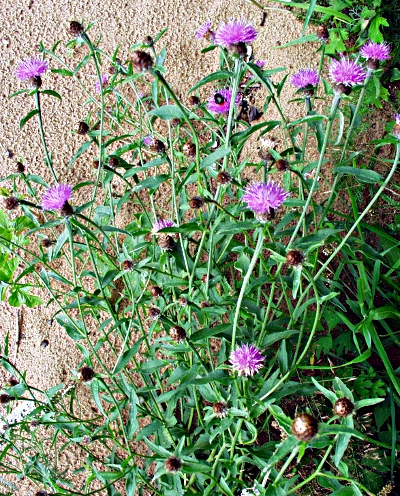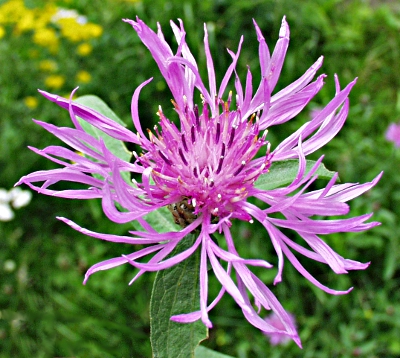Centaurea, knapweeds |

The
Persian
cornflower (Centaurea dealbata)
is native
to the Caucasus

At first glance, the Lesser knapweed may be mistaken for a thistle

The
ray florets of the Brown knapweed
are usually extended
conspicuously
According to Pliny, the scientific name refers to the centaur Chiron, who used the great Centaurium for wound healing. The English name comes from the late Middle English "knopweed" and refers to the rounded flower heads. Linnaeus described the species scientifically in 1754.
Comprising about 500 species, the knapweeds, due to the use of some species as ornamental plants, can be found all over the world. They are annual, biennial or perennial herbs, rarely shrubs, with stems that are erect, ascending or spreading, sometimes branched, grooved and sometimes winged. The basal and the alternate cauline leaves are glabrous or hairy, sessile or stalked, the lower ones often deeply lobed, the upper ones often smaller and undivided. In some species thorny leaves occur.
The the flower heads are arranged solitary or in corymbose inflorescences and may be red violet, purple, white or yellow. They consist only of more or less zygomorphic tubular florets – the outer ones are often extended, usually sterile and with approximately 5 cm long corolla lobes. The inner florets are more ore less radial, hermaphrodite and have 5 long and pointed corolla lobes. Florets at the base without chaffy leaves. The receptacle is flat and bristly. The tubular to ovoid or hemispherical involucre consists of several rows of scale-like arranged phyllaries, sometimes with membranous margins, that are often possess appendages which are serrated, fringed or spined, feathery, comb-shaped or shaped otherwise.
After pollination by butterflies or Hymenoptera the inferior ovary forms a barrel-shaped, somewhat flattened nut fruit (achene) with a pappus derived from the calyx, spines or narrow scales, or completely without calyx.
Like all asteraceas, knapweed possess five anthers that are connate to a tube, while the stamens are free. Within the still closed flowers, the anthers breaks open and release the pollen. Now the pistil slides into the tube and presses the pollen upwards with its collecting hairs. Then the flower opens with its white pollen, oozing out of the tube. If an insect touches the tube, it is shortened abruptly by lowering the turgor pressure, so that the pistil, which is now protruding from the tube, attaches the pollen to the insect.
Almost all knapweed species hybridize easily with each other and the bastards are often fertile. In this way hybrid swarms and clans arise, which are difficult to determine. This is aggravated by the fact that they can even hybridize with horticultural varieties. In addition, many representatives of knapweeds are very diversiform. In the past, many attempts were made to systematize the genus. Thus, divisions, groups, classes and aggregates were established and numerous subspecies were described. So far, the division into subspecies of some representatives is controversial and part of the current research.
| Floral formula: |
| * K0 or K=pappus [C(5) A5(connate)] G(2) inferior |
Historical publications
Dioscorides (1st century AD) describes the "great Kentaurion" as walnut-leaved with toothed leaf margins and blue flowers. The fruits were similar to that of the safflower (Carthamus tinctorius) and would be shrouded by woolly flowers. The root would be hard and firm, juicy and hot. He recommends it for example against cramps, stitches in the side, wheezing and coughing.
Plinius (about 23–79 AD) derives the name Centaurium from the greek mythology: Chiron (a centaur) visited Hercules and examined his weapons. He is said to have been wounded on his hoof by an arrow and have been healed with this herb. It would therefore also be called Chironium. The root in wine or water or a decoction of the root would have a strong healing effect on wounds.
Meaning of the species names
- gerstlaueri: named by Eugen Erdner after a friend, the prosecutor Lorenz Gerstlauer, who discovered the plant in 1903 in Neuburg near Marbach.
- jaceae: Jacea = old name of knapweeds
- nigra: lat. niger = black
- scabiosa: scabious
Interesting notes
- Cultivated varieties of Centaurea macrocephala and Centaurea dealbata are used as garden plants.